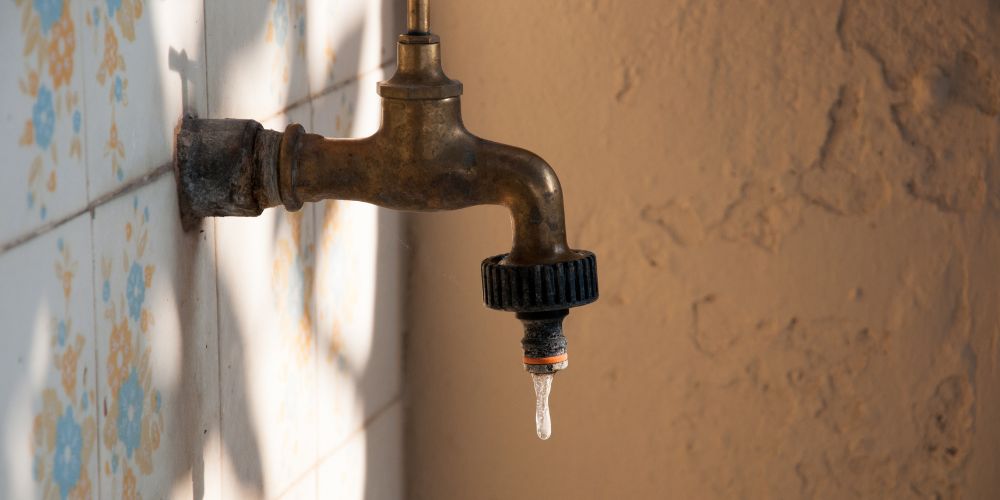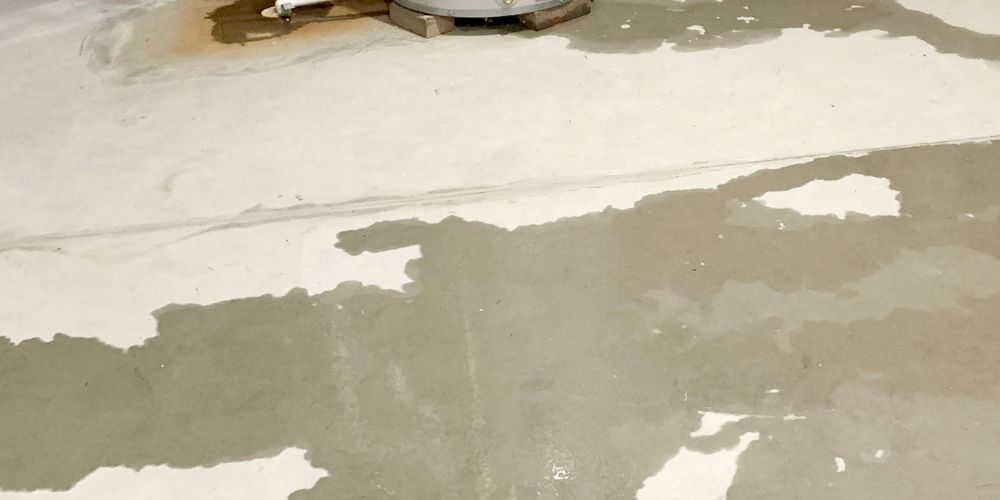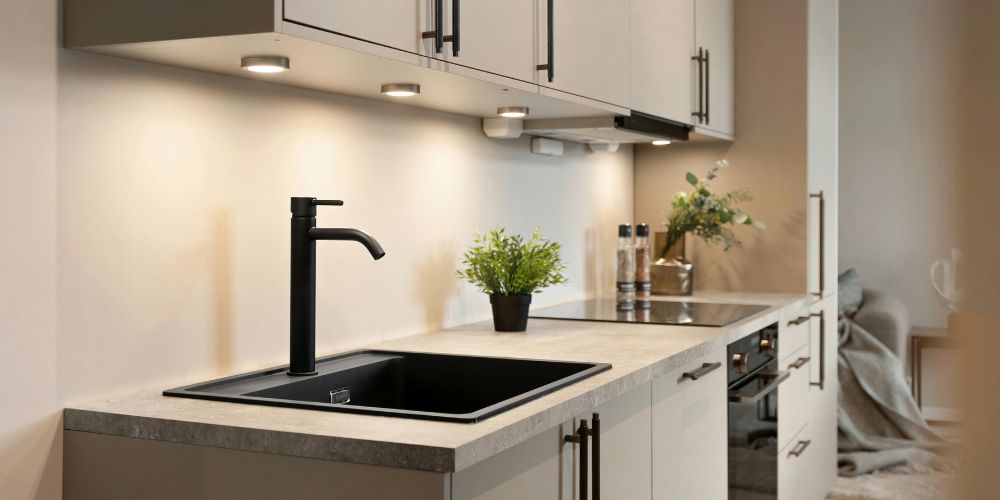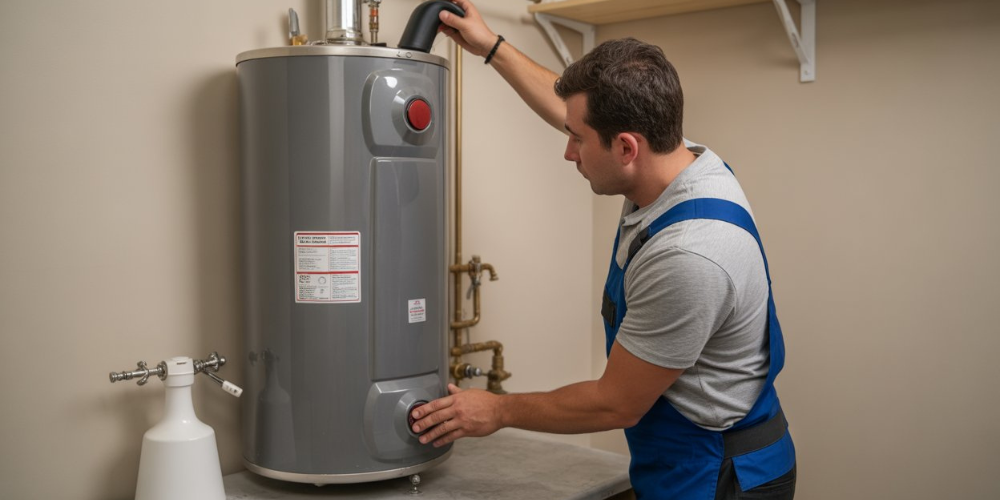Key Takeaways
- Water hardness is determined by the concentration of dissolved minerals, primarily calcium and magnesium. Hard water has higher mineral content, while soft water has lower levels.
- Hard water leads to limescale buildup in pipes and appliances, reducing their efficiency and lifespan, which can increase maintenance costs over time.
- Investing in a water softening system can mitigate the negative effects of hard water, improving appliance longevity and overall water quality.
Remember when water was just… water? Well, welcome to 2024, where your H2O might be living a double life.
For quite some time I thought ‘hard water’ was just ICE. But apparently, there’s a whole range of water hardness that’s got nothing to do with freezing.
If you’ve ever wondered why your neighbor’s hair always looks better than yours, the answer might be flowing right out of your tap. According to the U.S Geological Survey (USGS), an overwhelming majority approximately 85% of US homes receive hard water through their supply systems.
The key difference between hard and soft water lies in their mineral composition. Hard water contains higher concentrations of dissolved minerals, with calcium and magnesium being the primary contributors. These minerals, while not typically harmful to health, can have various effects on household activities and appliances.
Soft water, in contrast, has significantly lower levels of these dissolved minerals. This difference in mineral content leads to distinct characteristics and impacts in daily use, from how soap lathers to the potential for scale buildup in pipes and appliances.
The amount of dissolved minerals is measured in one of three ways:
- Grains per gallon (gpg)
- Parts per million (ppm)
- Milligrams per liter (mg/L)
Where, 1 gpg = 17.1 ppm or mg/L
| Water Hardness | gpg (approx.) | ppm (approx.) | mg/L (approx.) |
| Soft | < 1 | < 17 | < 17 |
| Slightly hard | 1-3.5 | 17-60 | 17-60 |
| Moderately hard | 3.5-7 | 60-120 | 60-120 |
| Hard | 7-10.5 | 120-180 | 120-180 |
| Tough | > 10.5 | > 180 | > 180 |
Who knew water could be so complicated, right? But don’t worry, by the end of this blog, you’ll be ready to drop some serious H2O knowledge at your next backyard BBQ!
What is Hard Water?
Water hardness is a scientific concept that can be observed in everyday life. From a technical standpoint, hard water refers to the concentration of dissolved calcium and magnesium ions.
Minerals in water often come from nature. As water flows over rocks and through soil, it picks up substances like calcium and magnesium. These minerals are common in our environment and in many foods and drinks we consume. They’re not usually harmful to us.
Besides these, water might also collect other minerals that can make it “hard,” such as:
However, for the average person, the effects of hard water are often more noticeable than its chemical composition.
You might recognize hard water in your home through several common signs. For instance, after washing your hands with soap, you may experience a lingering slippery sensation despite thorough rinsing. This occurs because the minerals in hard water react with soap, creating a residue that’s difficult to wash away completely.
One significant long-term effect of hard water is the accumulation of limescale, a chalky substance that can build up inside plumbing systems. This buildup narrows pipes, leading to reduced flow rates and water pressure.
In newer homes, particularly those built after the 1970s, limescale may be less of a concern due to modern plumbing materials and improved water treatment practices. However, regardless of your home’s age, being aware of hard water effects is crucial for informed decisions on water treatment and maintenance. If you experience ongoing issues with water flow or pressure, consider consulting a plumbing professional.
Hard water also causes accelerated wear and tear on appliances like dishwashers, washing machines, and water heaters due to limescale buildup. This shortens their lifespan and skyrockets maintenance costs.
What is Soft Water?
Soft water is a term used to describe water that is virtually free from dissolved minerals, particularly calcium and magnesium. Soft water is typically formed in regions where there is little to no presence of dissolved minerals. Pure rainwater is naturally soft because it hasn’t yet come into contact with the ground or rock formations that could add minerals. When rain falls directly into lakes, rivers, or streams without passing through mineral-rich soil, it remains soft.
Due to Soft water’s simpler chemical composition, it feels smoother to touch compared to hard water. It contains less than 17 parts per million (ppm) of dissolved minerals, making it ideal for households to improve the efficiency of their plumbing systems and the quality of their water-related tasks.
Only about 15% of American homes are blessed with naturally soft water, as most regions have varying degrees of hard water. This scarcity makes soft water a valuable resource, and many homeowners opt for water-softening systems to remove the excess minerals and enjoy the benefits of smooth, mineral-free water.
Hard Water vs. Soft Water
Hard water contains high levels of minerals like calcium and magnesium, leading to limescale buildup and reduced soap effectiveness. Soft water has lower mineral content, feels smoother, and is gentler on skin and hair, but may contain higher sodium levels.
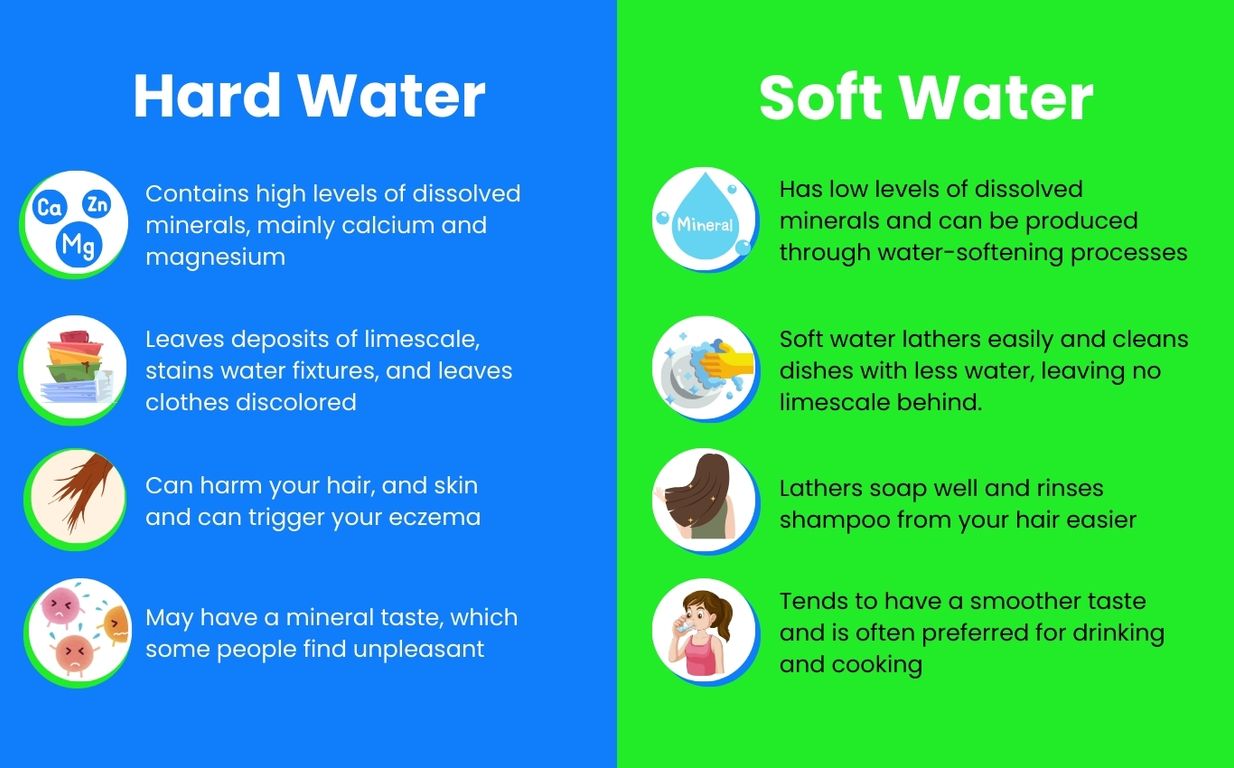
Mineral Content
- Hard Water: Contains high levels of dissolved minerals, mainly calcium and magnesium. These minerals are picked up as water passes through soil and rock layers.
- Soft Water: Has low levels of dissolved minerals. It is naturally occurring in some regions or can be produced through water-softening processes.
Effects on Cleaning and Soap
- Hard Water: Reduces the effectiveness of soaps and detergents, leading to soap scum and buildup. This can make cleaning tasks more difficult and require more product.
- Soft Water: Enhances the lathering and cleaning power of soaps and detergents, reducing the amount needed and leaving surfaces and fabrics cleaner.
Impact on Appliances and Plumbing
- Hard Water: Causes limescale buildup in pipes, water heaters, and appliances, which can lead to inefficiency, higher energy costs, and reduced lifespan of equipment.
- Soft Water: Prevents limescale buildup, helping to maintain the efficiency and longevity of appliances and plumbing systems.
Taste and Health Implications
- Hard Water: May have a mineral taste, which some people find unpleasant. It also provides dietary calcium and magnesium, which are essential nutrients.
- Soft Water: Tends to have a smoother taste and is often preferred for drinking and cooking, though it lacks the mineral content of hard water.
Regional Availability
- Hard Water: More common in areas with high mineral content in the soil and bedrock, affecting about 85% of U.S. households.
- Soft Water: Naturally occurs in regions with low mineral content in the environment or can be achieved through water softening systems.
Impact on Skin and Hair
- Hard Water: The minerals in hard water can leave residues on skin and hair, leading to dryness and irritation.
- Soft Water: Soft water rinses more completely, leaving skin and hair feeling softer and cleaner.
Environmental Considerations
- Hard Water: While not harmful to the environment, using hard water can lead to increased consumption of cleaning products and detergents due to decreased efficiency.
- Soft Water: Typically results in lower consumption of soaps and detergents, reducing chemical runoff into the environment.
Economic Impact
- Hard Water: This can lead to higher household expenses over time due to the need for more cleaning products, frequent repairs, and premature replacement of appliances affected by limescale buildup.
- Soft Water: Generally associated with lower maintenance and operational costs for household systems and appliances.
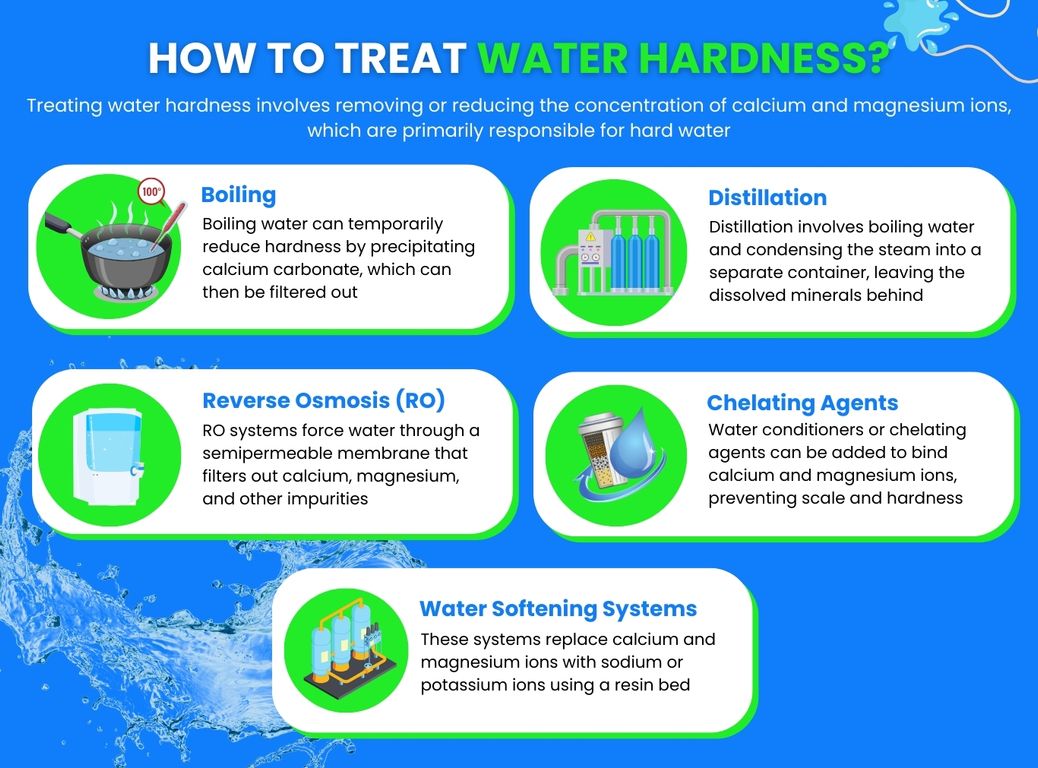
How to Treat Water Hardness?
Treating water hardness involves removing or reducing the concentration of calcium and magnesium ions, which are primarily responsible for hard water. It’s important to note that while these methods soften water, they don’t typically remove other contaminants. Water softeners aren’t the same as water purifiers. If you’re concerned about water quality beyond hardness, you may need additional filtration systems.
1. Boiling
Boiling water can temporarily reduce hardness by precipitating calcium carbonate, which can then be filtered out. However, this method is only practical for small quantities of water.
2. Distillation
Distillation involves boiling water and condensing the steam into a separate container, leaving the dissolved minerals behind. This method is effective but energy-intensive and slow.
3. Reverse Osmosis (RO)
RO systems force water through a semipermeable membrane under high pressure, allowing water molecules to pass through while blocking larger particles, including calcium and magnesium ions. This method is effective but can be slower and produce wastewater.
4. Chelating Agents
Chelating agents or water conditioners can be added to the water supply to bind with calcium and magnesium ions, preventing them from causing scale and hardness. These are often used in industrial settings.
5. Water Softening Systems
Water softening systems tackle hard water by replacing calcium and magnesium ions with sodium or potassium ions. This is done through a resin bed that captures the hardness ions as the water flows through. The resin then releases sodium or potassium into the water, making it softer.
What is Water Softening?
Water softening removes calcium, magnesium, and other metal ions from hard water, turning it into soft water. This process improves cleaning efficiency by preventing soap scum and extends the lifespan of plumbing and appliances by reducing scale buildup. Ion exchange is commonly used, replacing hard water ions with sodium or potassium ions, enhancing water quality for various uses.
How Does a Water Softener Work
Water softeners are ingenious devices that transform hard water into soft water through a fascinating process called ion exchange. Resin beads at the core of a water softener is a tank filled with tiny resin beads. These beads are specially charged with sodium ions, making them the key players in the softening process.
The Softening Process
- Hard water, rich in calcium and magnesium ions, enters the softener tank.
- As water flows through the resin bed, a swap occurs. The resin beads attract and hold onto the calcium and magnesium ions.
- In exchange for capturing the hardness minerals, the resin beads release sodium ions into the water.
- The water leaving the tank is now considered “soft,” with significantly reduced mineral content.
Over time, the resin beads become saturated with calcium and magnesium ions. At this point, the system goes through a regeneration cycle.
- A saltwater solution (brine) is flushed through the tank.
- The brine washes away the accumulated hardness minerals from the resin beads.
- The beads are recharged with fresh sodium ions, ready for the next round of softening.
This regeneration process ensures that your water softener continues to function effectively, providing a consistent supply of soft water for your home.
The Bottom Line
In the debate between hard and soft water, the choice depends on your specific needs and preferences. Hard water contains beneficial minerals but can cause scale buildup and reduce appliance efficiency. Soft water, with fewer minerals, provides a smoother touch and better cleaning performance.
If hard water issues like limescale and skin irritation are a concern, consider a water-softening system. These systems can improve appliance longevity and enhance water quality.
If you’re interested in softening your water, talk with PlumbSmart’s plumbing expert about how the system may affect your home’s plumbing.


